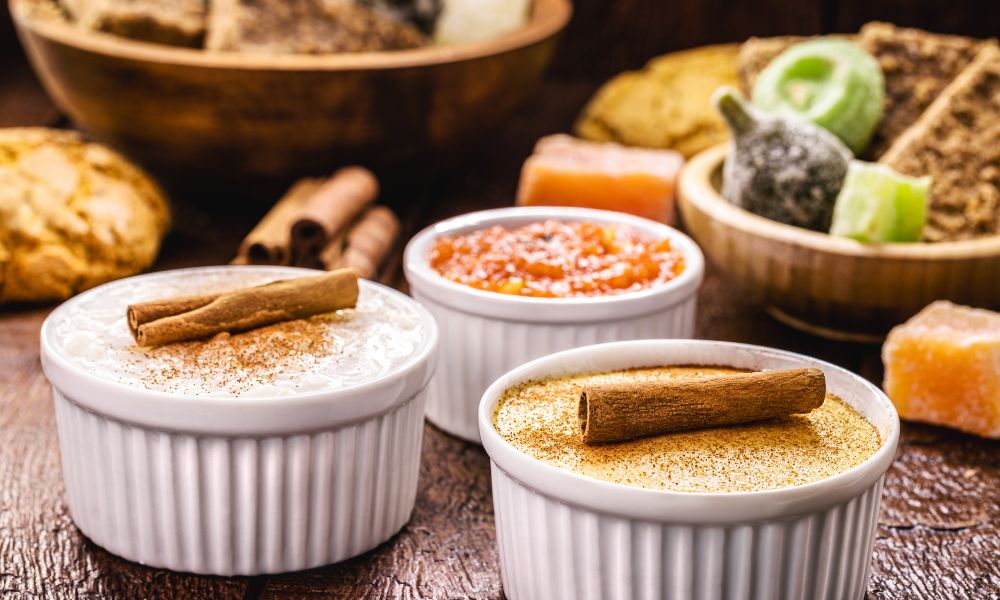The mungunza, also known as northeastern canjica, is one of the most traditional delicacies in Northeastern cuisine. With its sweetness and creamy texture, this dish is prepared mainly during the June festivals, but it is also consumed year-round in several regions of Brazil. Made with white corn and coconut milk, mungunzá is a sweet treat that conquers all palates, bringing a little piece of the Northeast to your table.
You will learn how to prepare the mungunza in the most delicious and authentic way, so you can enjoy this true delight at home.
Ingredients:
- 500g of mungunzá corn (white corn)
- 1 liter of coconut milk (preferably coconut milk)
- 1 liter of whole milk
- 1 cup sugar (or to taste)
- 1/2 cup condensed milk
- 1 cinnamon stick
- Cloves to taste
- 1 pinch of salt
- 1 tablespoon vanilla essence (optional)
- 1 cup grated coconut (fresh or dried, to taste)
- Roasted and ground peanuts (for decoration, optional)
Directions:
1. Prepare the Corn:
The first step to preparing mungunzá is to hydrate the corn. In a large pot, place the mungunzá corn and add enough water to cover. Cook the corn over medium heat until it is very soft, which can take about 1 to 2 hours. During cooking, check to see if you need to add more water so that the corn does not burn or stick to the bottom of the pot. If you prefer a faster preparation, you can soak the corn for a few hours before cooking, which will reduce the cooking time.
2. Prepare the Cream:
In another saucepan, combine the coconut milk, whole milk, sugar, condensed milk, cinnamon and cloves. Bring the mixture to a boil over low heat, stirring occasionally until the sugar dissolves completely and the ingredients are combined. Let it simmer for about 10 minutes, until the milk thickens slightly and the cinnamon aroma spreads.
3. Mix the Cooked Corn with the Cream:
When the corn is well cooked and soft, drain the excess water and add the corn to the pan with the cream. Mix well and continue cooking over low heat, stirring constantly to prevent the bottom from burning. Let the munguzá cook for about 20 to 30 minutes, until the liquid has reduced and the mixture is very creamy. During cooking, if necessary, add more milk to adjust the consistency and make the dish creamier.
4. Add the Coconut and Finish:
When the mungunzá reaches the desired consistency, add the grated coconut and vanilla essence (if using). Mix well and cook for another 5 minutes to incorporate the coconut into the dish. Taste and adjust the sugar, if necessary, according to your sweetness preference.
5. To serve:
Mungunzá can be served hot or cold, depending on your preference. If you wish, decorate with roasted and ground peanuts on top for a special, crunchy touch, or simply finish with a little more grated coconut.
Important Tips:
- Grated coconut: If you prefer a more intense coconut flavor, use freshly grated coconut. Dried coconut is also a good option, but it may change the texture of the dish a little.
- Sweetener: If you want a less sweet or healthier version, you can replace the sugar with natural sweeteners like honey or agave, but the flavor will be slightly different.
- Cooking time: The cooking time for corn can vary depending on the quality and quantity of corn. If it is taking too long to cook, add more water or, if necessary, soak the corn for longer.
Curiosities about Mungunzá:
- Mungunzá has its roots in indigenous cuisine, which used corn in various preparations. However, the sweet version with milk, coconut and sugar is an adaptation that became famous mainly in the Northeast of Brazil.
- During the June festivals, mungunzá is one of the most served dishes, along with other delicacies such as rice pudding, canjica and cural.
- The dish is also known for its energy-giving properties, being a good source of carbohydrates and, when served with coconut and milk, a nutritious and tasty food.

